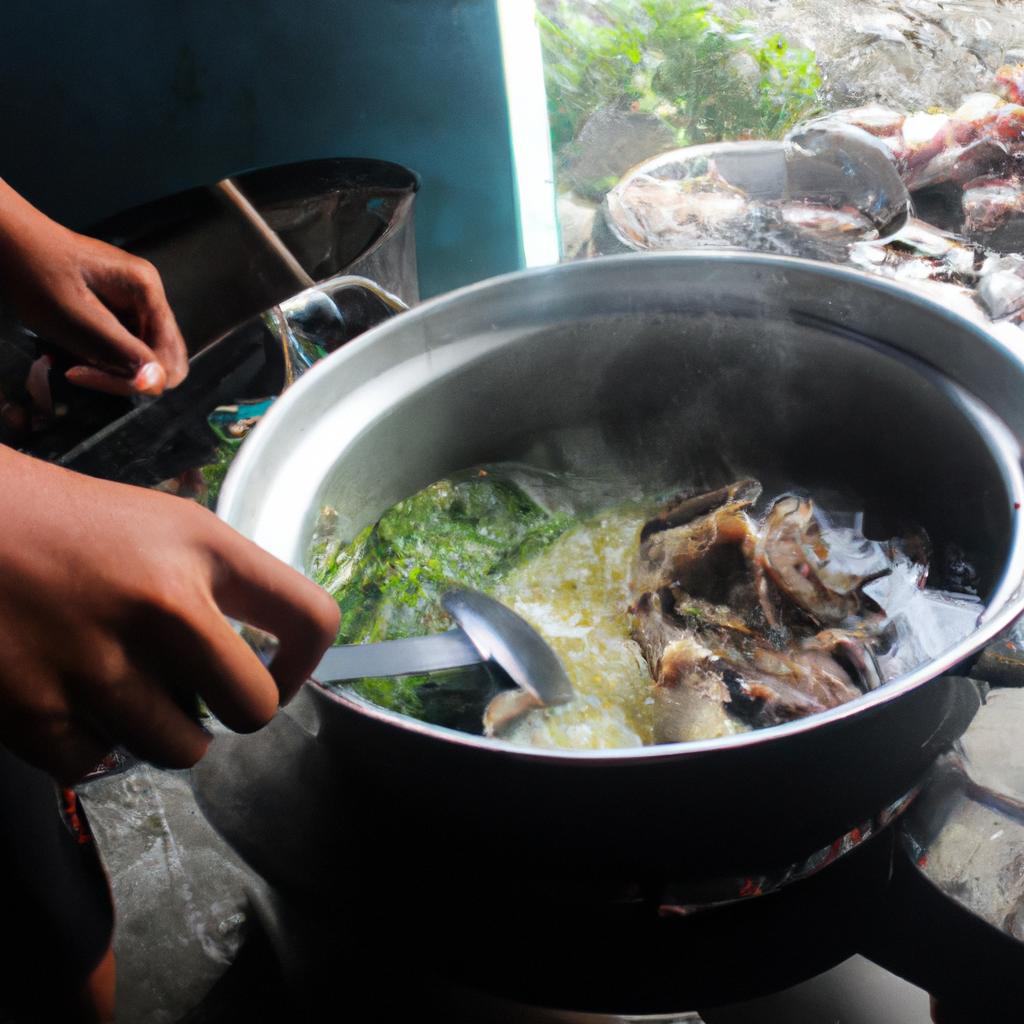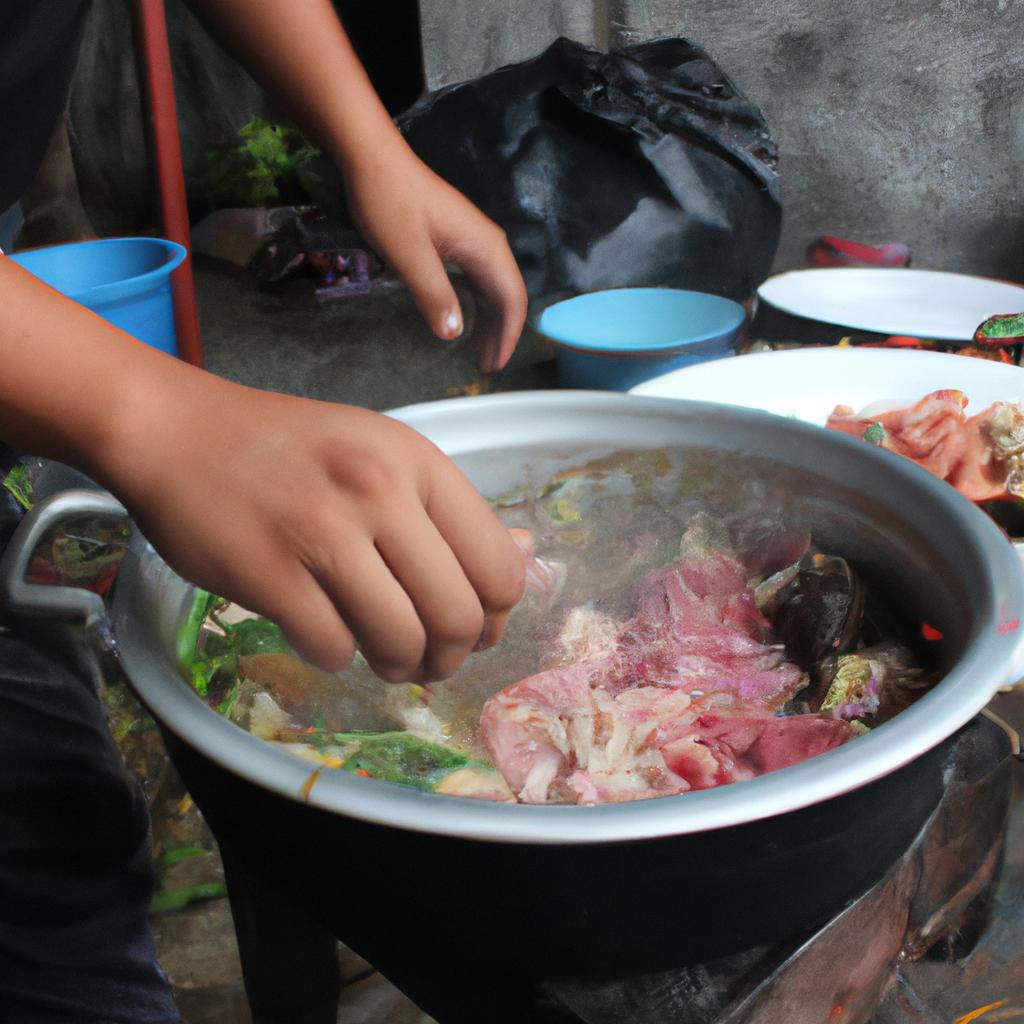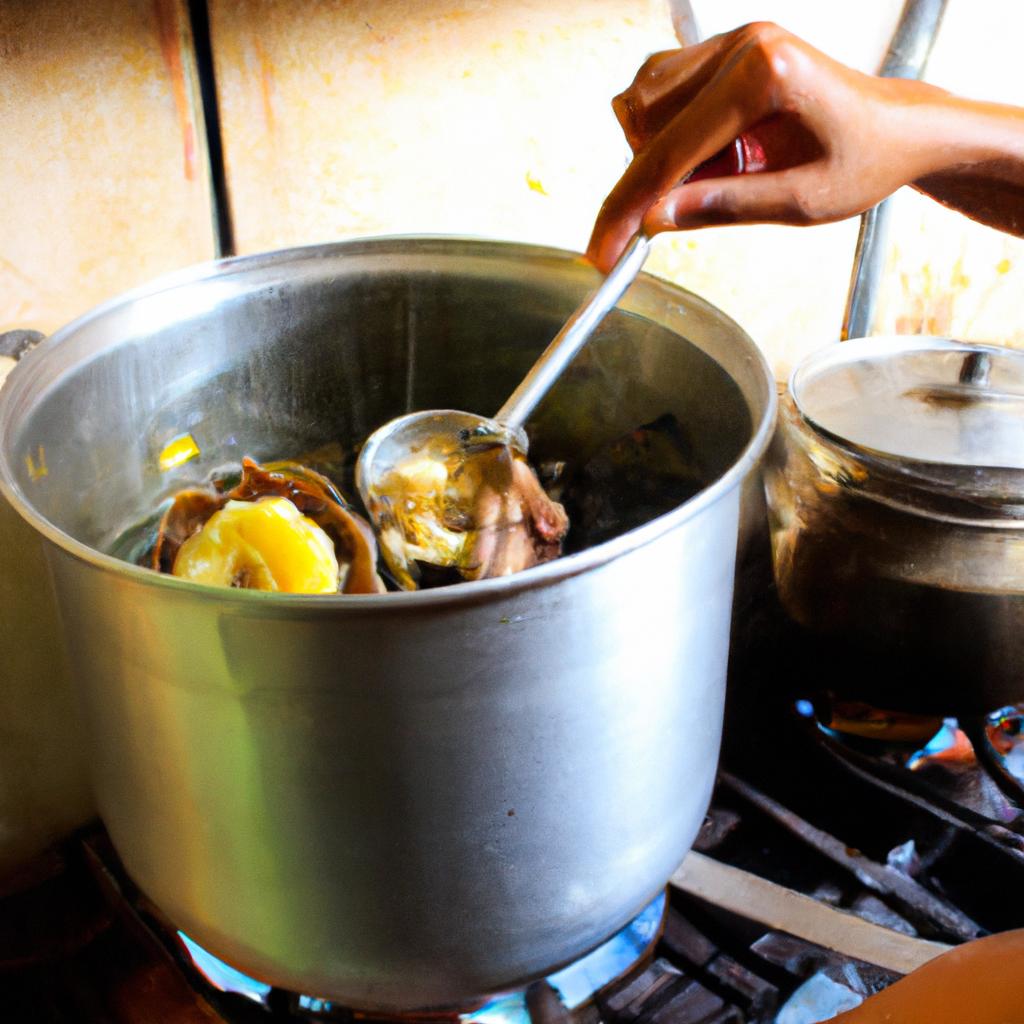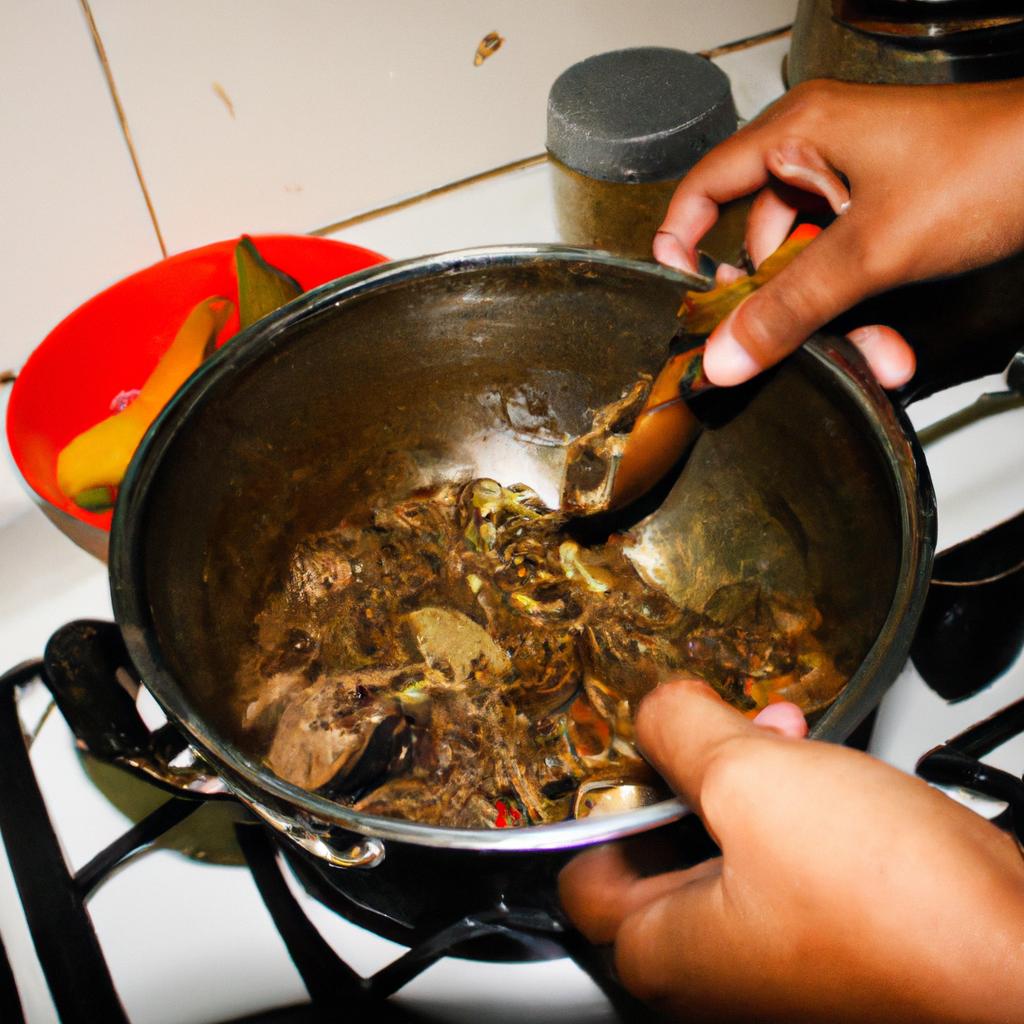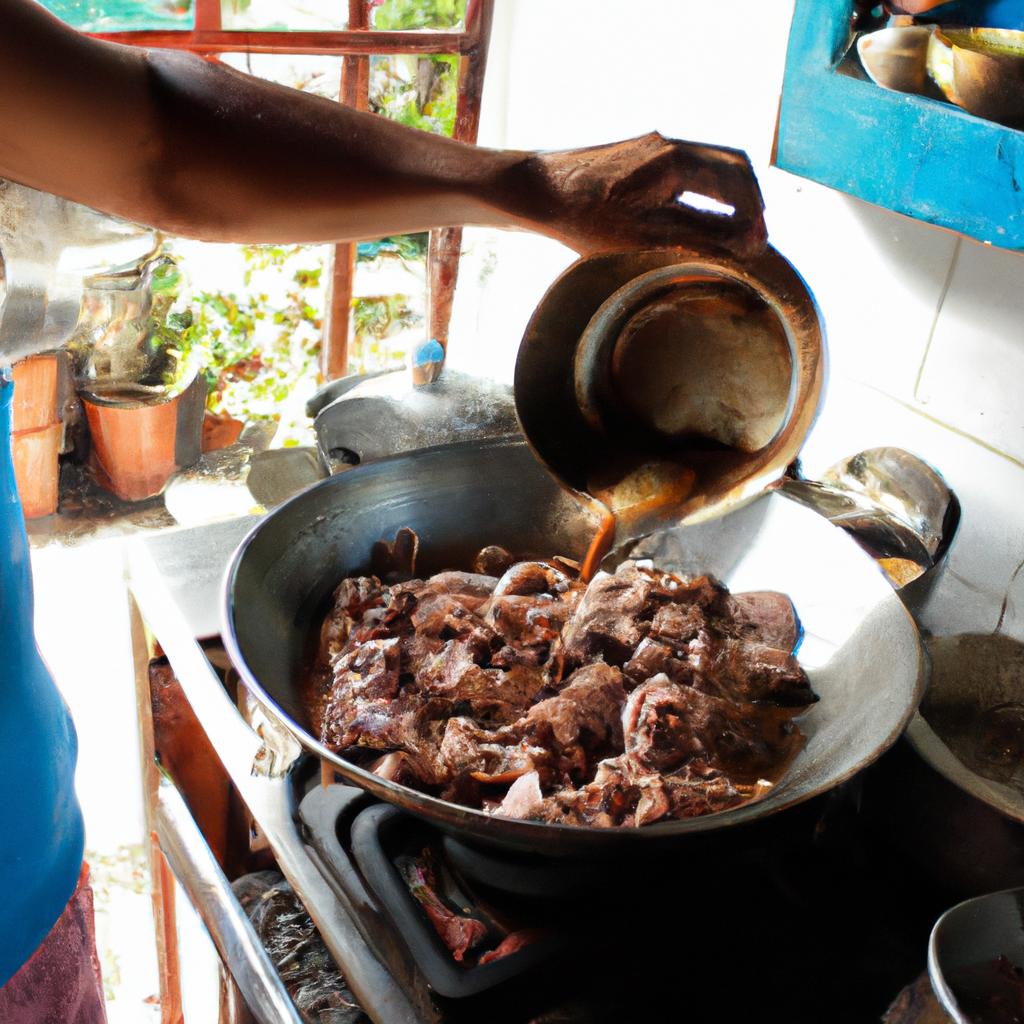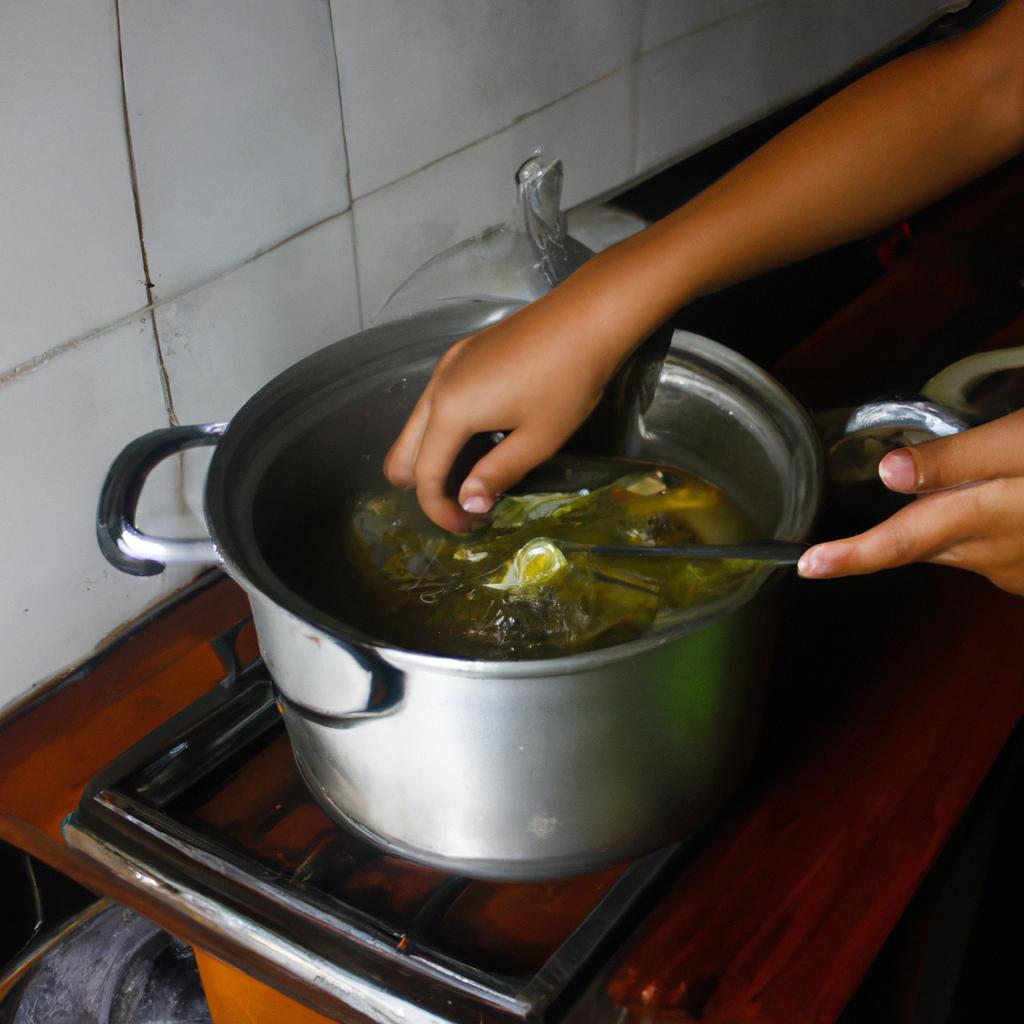Bulalo, a traditional Filipino dish known for its rich and flavorful broth, has become a staple in Filipino cuisine. Its historical roots can be traced back to the early Spanish colonization of the Philippines. During this period, the Spaniards introduced various cooking techniques and ingredients that greatly influenced local culinary traditions. One example is the method of slow-cooking beef marrow bones to create a delectable soup base, which eventually evolved into what we now know as bulalo.
The origins of bulalo are deeply intertwined with the cultural exchange between Spain and the Philippines. As Spanish colonizers settled in different regions across the archipelago, they brought with them their own food practices and preferences. They discovered that boiling beef shank bones for an extended period allowed for maximum extraction of flavors from the bone marrow, resulting in a nourishing broth. Over time, Filipinos adapted this technique by incorporating local herbs and vegetables such as corn, cabbage, and potatoes into the dish, adding layers of complexity to its taste profile.
This article aims to delve deeper into the historical development of bulalo as a significant part of Filipino gastronomy. By exploring its Spanish influences and subsequent adaptations made by Filipinos throughout history, we gain insight into how this humble yet highly regarded delicacy has become a beloved comfort food in the Philippines today. Filipino cuisine is known for its fusion of flavors, and bulalo perfectly exemplifies this culinary blending. The slow-cooking method from Spain combined with the use of local ingredients showcases the ingenuity and resourcefulness of Filipino cooks.
Throughout history, bulalo has evolved to reflect regional variations and personal preferences. In some provinces, additional ingredients like saba bananas or taro leaves are added to enhance the flavor profile further. Different cooking techniques have also emerged, such as grilling or roasting the bones before simmering them for an even richer taste.
Bulalo’s popularity can be attributed not only to its deliciousness but also to its perceived health benefits. The bone marrow in bulalo is believed to be rich in nutrients like calcium and collagen, making it highly sought after for its potential therapeutic properties.
Today, bulalo is commonly enjoyed in family gatherings, celebrations, or simply as a comforting meal on rainy days. It is often served with steamed rice and paired with condiments like fish sauce or calamansi (a local citrus fruit) for added tanginess.
As Filipino cuisine continues to evolve and adapt over time, bulalo remains a testament to the country’s rich culinary heritage. Its historical roots remind us of the cultural exchange between Spain and the Philippines while celebrating the creativity and resilience of Filipino cooks who transformed a simple soup into a national treasure.
Pre-colonial origins of the dish
Pre-colonial origins of the dish
Imagine a small village nestled in the lush mountains of the Philippines. The air is thick with the aroma of simmering broth, and locals gather around a large pot filled to the brim with succulent beef bones, vegetables, and spices. This communal cooking scene represents just one example of how bulalo, a traditional Filipino delicacy, has its roots deeply intertwined with pre-colonial history.
To truly appreciate the origins of bulalo, it is essential to understand the cultural context in which it emerged. In pre-colonial times, indigenous communities relied heavily on agriculture and fishing for sustenance. They cultivated an array of crops such as rice, corn, root vegetables like taro and sweet potatoes, and various herbs and spices that flavored their dishes. These ingredients formed the foundation upon which bulalo would later be built.
The significance of bulalo within these communities can be seen through several key aspects:
- Nourishment: Bulalo was not merely a meal but also served as a source of nourishment for individuals engaged in physically demanding activities such as farming or hunting.
- Community Bonding: The act of preparing and sharing bulalo fostered strong social ties among community members by creating opportunities for conversation and unity.
- Culinary Heritage: Passed down from generation to generation, bulalo represented more than just a recipe; it embodied ancestral wisdom and cultural traditions.
- Seasonal Adaptability: The adaptability of bulalo allowed for variations depending on available ingredients throughout different seasons.
| Ingredients | Cooking Method | Time | Purpose |
|---|---|---|---|
| Beef Bones | Simmering | Several hours | Extract flavor |
| Vegetables | Boiling | 30 minutes | Enhance taste |
| Spices | Seasoning | As needed | Add aromatic notes |
| Root Vegetables | Stewing | Variable | Provide sustenance |
As we delve into the historical origins of bulalo, it becomes apparent that this dish is more than just a culinary creation. It embodies centuries-old traditions, community values, and an understanding of local ingredients. The influence of Spanish colonization on bulalo will be explored in the subsequent section, shedding light on how external forces shaped its evolution.
Transitioning seamlessly to the next section, let us now explore the profound impact of Spanish colonization on bulalo.
Influence of Spanish colonization on bulalo
From the pre-colonial origins of bulalo, we now delve into its transformation under Spanish influence. One fascinating case study is how the dish evolved in the province of Batangas, known for its rich culinary heritage. Here, bulalo took on unique characteristics that reflect both native traditions and Spanish culinary techniques.
During the Spanish colonization period, several changes occurred in Filipino cuisine as a result of cultural exchange between the locals and their colonizers. In the case of bulalo, this can be observed through certain key elements. First, there was an introduction of new ingredients such as tomatoes and potatoes which were brought by the Spaniards from their homeland. These additions provided additional layers of flavor to the broth and enhanced the overall taste profile of bulalo.
Secondly, Spanish cooking methods influenced how bulalo was prepared. Instead of simply boiling beef bones with vegetables and spices like in its pre-colonial form, the Spaniards introduced stewing techniques that involved simmering meat over low heat for extended periods. This slow-cooking process allowed flavors to develop more intensely and resulted in a richer and thicker broth.
To gain further insight into these transformations during Spanish colonization, it is worth considering some emotional aspects associated with this evolution:
- Nostalgia: The changes made to bulalo evoke nostalgia among Filipinos who appreciate how it has been passed down through generations.
- Cultural fusion: The blending of indigenous flavors with foreign influences reflects a vibrant cultural exchange where diverse traditions come together harmoniously.
- Adaptability: Bulalo’s ability to adapt to new ingredients and cooking techniques showcases its versatility as a dish deeply ingrained within Philippine food culture.
- Resilience: Despite being subject to external influences, bulalo remains an enduring symbol of Filipino identity due to its continued popularity across different regions.
These emotional connections serve as reminders of how food carries not only sustenance but also stories embedded within them. To provide a clearer overview of the changes, we have prepared a table below that highlights the distinct characteristics of bulalo before and after Spanish colonization:
| Pre-colonial Bulalo | Spanish-influenced Bulalo |
|---|---|
| Primarily made from beef bones | Additional ingredients such as tomatoes and potatoes introduced |
| Vegetables used for flavoring included native varieties like onion, garlic, and ginger | Broth enriched with flavors from new spices brought by the Spaniards |
| Simple boiling method employed | Slow-cooking techniques adopted to enhance taste and create a thicker broth |
As bulalo continued to evolve under Spanish influence, it set the stage for further transformations in later periods. The subsequent section will explore how American presence in the Philippines shaped the dish into what it is today – an integral part of Filipino cuisine enjoyed across the country.
Transitioning into the subsequent section about “Evolution of bulalo through American influence,” we witness yet another significant step in its culinary journey.
Evolution of bulalo through American influence
Transitioning from the previous section’s exploration of the Spanish influence on bulalo, we now delve into its evolution under American influence. This period marked a significant shift in the culinary landscape due to new ingredients and cooking techniques introduced by American colonizers.
To illustrate this transformation, let us consider a hypothetical scenario involving a local Filipino chef during the early 20th century. Chef Juanito, known for his traditional approach to cooking bulalo, encounters an American soldier stationed in Manila. Intrigued by the unique flavors brought by the Americans, he decides to experiment with their ingredients while still honoring the essence of the dish.
During this time, several changes took place that impacted how Filipinos prepared bulalo. Notable aspects include:
-
Broth Base Innovation:
- Incorporation of beef bones alongside native bone marrow.
- Introduction of spices such as bay leaves and thyme.
- Utilization of onion and garlic for added depth of flavor.
-
Vegetable Inclusion:
- Integration of corn cobs into the broth for sweetness.
- Addition of green beans or string beans for freshness and color contrast.
- Experimentation with other vegetables like carrots or cabbage.
-
Noodle Expansion:
- Adoption of egg noodles (miki) or glass noodles (sotanghon) in some variations.
- Blending Filipino noodle soup traditions with American influences.
-
Enhanced Meat Cuts:
- Exploration beyond traditional shank cuts to encompass beef ribs or even brisket.
- Adaptation to suit different preferences and availability.
This amalgamation resulted in a more diverse range of flavors within the beloved dish, appealing to both locals and foreigners alike. While preserving its core elements, bulalo embraced new ingredients and techniques to suit evolving tastes.
Transitioning to the subsequent section on regional variations of the dish, we witness how these culinary adaptations continued to evolve across different parts of the Philippines. By exploring the unique characteristics found in various regions, we gain a deeper appreciation for the rich tapestry of bulalo’s history and cultural significance.
Regional variations of the dish
Amidst the rich tapestry of Filipino cuisine, bulalo stands out as a dish deeply rooted in history and tradition. Now, let us delve into the regional variations that have arisen over time, further enriching the culinary landscape.
To illustrate this point, consider the case study of two provinces located on different islands of the Philippines: Batangas in Luzon and Bacolod in Negros Occidental. Despite both regions having their own distinct interpretations of bulalo, they share commonalities that highlight its enduring popularity across the country.
Regional variations of bulalo can be attributed to several factors:
- Local ingredients: Each region showcases unique flavors by incorporating locally available ingredients like vegetables or herbs.
- Cultural influences: The diverse cultural heritage within these regions contributes to subtle differences in cooking techniques and seasoning preferences.
- Climate considerations: The weather plays a significant role in shaping regional variations; for instance, colder provinces may add more spices compared to warmer ones.
- Historical context: Historical events and migration patterns also contribute to local adaptations, resulting in an array of delightful flavor profiles.
To emphasize these regional nuances visually, let us explore them using a table:
| Region | Key Ingredients | Notable Characteristics |
|---|---|---|
| Batangas | Beef shanks | Rich broth with strong garlic flavor |
| Bacolod | Chicken | Tangy broth infused with lemongrass |
This side-by-side comparison illustrates how each region’s choice of protein alters not only the taste but also adds depth to the overall experience.
As we conclude this exploration into regional variations, it becomes evident that despite changes brought about by external influences such as colonization and globalization, Filipinos have managed to preserve their culinary traditions and adapt them to local contexts. The evolving nature of bulalo demonstrates the resilience of Filipino cuisine, continuously embracing innovation while remaining deeply rooted in history.
Transitioning seamlessly into our subsequent section about the cultural significance of bulalo in Filipino cuisine, we will delve further into its traditional roots and enduring popularity among Filipinos from all walks of life.
Cultural significance of bulalo in Filipino cuisine
Regional variations of the dish have played a significant role in shaping the diverse culinary landscape of the Philippines. Let us explore some examples to understand how bulalo, a traditional Filipino delicacy, has evolved across different regions.
In Northern Luzon, particularly in the province of Batangas, bulalo is known for its rich and flavorful broth made from boiling beef shanks and marrow bones over low heat for several hours. This version showcases the simplicity of ingredients while highlighting the essence of bone marrow as it infuses into the soup. The tender meat and succulent taste make it a beloved comfort food among locals and tourists alike.
On the other hand, in Visayas region, specifically in Iloilo City, their variation of bulalo called “Kansi” incorporates souring agents such as batwan or sampaloc (tamarind) into the broth. This addition gives Kansi its distinct tangy flavor that perfectly complements the richness of beef. Often served with native vegetables like taro leaves and banana blossoms, Kansi offers a unique combination of tastes that satisfies both locals and adventurous eaters.
Further south in Mindanao, Zamboanga City boasts its own take on this iconic dish with their Tiyula Itum style bulalo. What sets it apart is the use of burnt coconut meat or locally known as “pahut” which gives the soup a dark color and smoky aroma. Combined with spices like ginger, lemongrass, turmeric, and chili peppers, Tiyula Itum creates an explosion of flavors that delight even the most discerning palates.
To illustrate these regional variations visually:
-
Bulalo: Regional Variations
-
Batangas Style
- Rich and flavorful broth
- Slow-cooked beef shanks
- Highlighted bone marrow essence
-
Iloilo City’s Kansi
- Tangy flavored broth with souring agents
- Native vegetables as accompaniments
-
Zamboanga City’s Tiyula Itum
- Dark-colored broth from burnt coconut meat
- Spices for a smoky and flavorful taste
-
These regional variations showcase the creativity and adaptability of Filipino cuisine, as each region infuses its unique flavors into the traditional bulalo recipe. The cultural significance of these adaptations extends beyond culinary preferences; it represents the diverse heritage and history ingrained in Filipino culture.
Appreciating how bulalo has evolved across different regions helps us understand the modern adaptations and innovations that have emerged over time.
Modern adaptations and innovations of bulalo
Transitioning from the previous section, which explored the cultural significance of bulalo in Filipino cuisine, we now delve into the modern adaptations and innovations of this beloved dish. To illustrate its versatility, let us consider a hypothetical scenario where a renowned chef reimagines bulalo by infusing it with international flavors.
In this case study, Chef Rodriguez introduces an innovative twist to traditional bulalo by incorporating Moroccan spices and herbs such as cumin, coriander, and saffron. He believes that these aromatic ingredients will add depth and complexity to the rich beef broth while maintaining the essence of the dish. By combining elements from two distinct culinary traditions, Chef Rodriguez aims to create a fusion experience for diners seeking new gastronomic adventures.
The emergence of modern adaptations and innovations has contributed to the continued popularity of bulalo among both locals and tourists alike. These contemporary variations are often inspired by global culinary trends or tailored to cater to evolving dietary preferences. Here are some notable examples:
- Vegan Bulalo: In response to growing demands for plant-based options, chefs have developed vegan versions of bulalo using vegetable stock instead of beef broth. This adaptation showcases how tradition can be adapted to accommodate different lifestyles.
- Seafood Bulalo: Some coastal regions have also embraced seafood as an alternative protein source in their version of bulalo. A medley of fresh fish, prawns, mussels, and squid is added to the broth alongside traditional ingredients like corn and cabbage.
- Fusion Bulalo: As seen in our case study example above, fusion dishes that combine bulalo with other cuisines have gained traction. Chefs experiment with flavors from various cultures—such as Japanese miso or Thai lemongrass—to give a unique spin on this classic Filipino dish.
- Upscale Bulalo: Fine dining establishments have elevated bulalo into an upscale offering by using premium cuts of beef and enhancing the presentation through meticulous plating techniques. This adaptation caters to a more refined palate while still paying homage to the dish’s humble origins.
To further illustrate the diverse adaptations of bulalo, consider the following table that showcases different variations found across the Philippines:
| Region | Variation | Key Ingredient(s) |
|---|---|---|
| Metro Manila | Spicy Bulalo | Chili peppers |
| Bicol | Coconut Milk Bulalo | Coconut milk |
| Ilocos Norte | Papaitan | Bitter melon |
| Visayas | Sinigang na Bulalo | Tamarind or guava broth |
These examples highlight how bulalo has transcended its traditional roots and continues to evolve in response to changing tastes and culinary influences. As chefs experiment with new flavors and techniques, they contribute to the ongoing narrative of this Filipino delicacy, ensuring its enduring presence on dining tables throughout the country and beyond.


